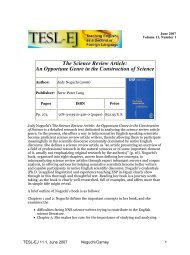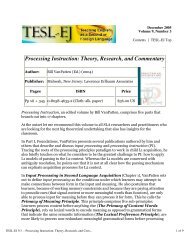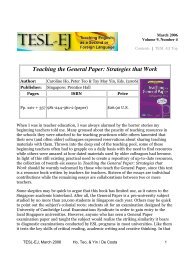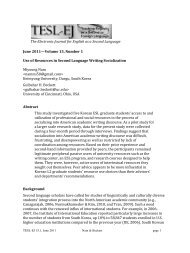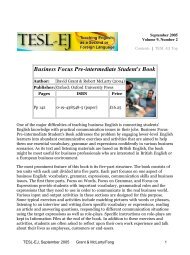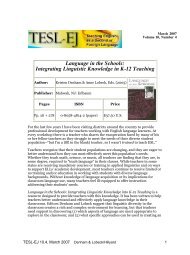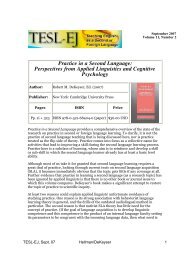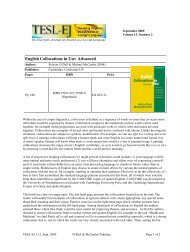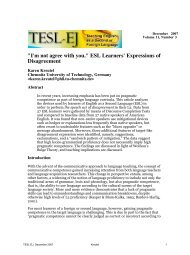Longman English Interactive - TESL-EJ
Longman English Interactive - TESL-EJ
Longman English Interactive - TESL-EJ
Create successful ePaper yourself
Turn your PDF publications into a flip-book with our unique Google optimized e-Paper software.
September 2005<br />
Volume 9, Number 2<br />
Contents | <strong>TESL</strong>-<strong>EJ</strong> Top<br />
<strong>Longman</strong> <strong>English</strong> <strong>Interactive</strong><br />
Title:<br />
<strong>Longman</strong> <strong>English</strong><br />
<strong>Interactive</strong><br />
Levels: 1 & 2<br />
Release Date: 2003-01-08<br />
Publisher: Pearson <strong>Longman</strong><br />
Four skills based intgegrated<br />
Product Type:<br />
program<br />
Platform: Windows<br />
Windows 98, XP, 2000 with<br />
service Pack 2 (or higher), or NT<br />
4.0 with service pack 5 (or higher)<br />
Pentium II processor 400+ MHz<br />
64+ MB RAM (128 MB<br />
recommended)<br />
16 bit graphics card<br />
Monitor resolution of 800 x 600<br />
or higher<br />
Sound card, microphone, and<br />
speakers (Microphones plugged<br />
System into USB ports are not supported.)<br />
Requirements: 10X CD-ROM drive<br />
Floppy disk drive<br />
Internet Explorer 5.0 or higher<br />
Macromedia's Flash 5 (or higher),<br />
Shockwave 8 (or higher), Apple's<br />
QuickTime 5 (or higher), and Java<br />
1.4.1 (or higher) plug-ins.<br />
These components are on the CD<br />
if the user does not already have<br />
them.<br />
<strong>TESL</strong>-<strong>EJ</strong>, Sept. 2005 <strong>Longman</strong> <strong>English</strong> <strong>Interactive</strong>/Hufton 1
Adobe Acrobat reader 4.0 (or<br />
higher)<br />
Introduction<br />
<strong>Longman</strong> <strong>English</strong> <strong>Interactive</strong> (LEI) is a multimedia program for ESL students<br />
available in American or British <strong>English</strong>. The program provides students with the<br />
opportunity to develop their skills in listening, reading, writing, speaking, grammar,<br />
pronunciation, and vocabulary. The courseware comprises a four-level program<br />
ranging from beginner to high intermediate. Each level has over 100 hours of<br />
instruction, including instruction both on the computer and materials for regular<br />
classroom instruction. This review will evaluate levels one and two.<br />
<strong>Longman</strong> markets level 1 to beginner level learners, but teachers should be aware<br />
that students with no background in <strong>English</strong> would find it very challenging.<br />
Students should have a basic knowledge of <strong>English</strong> vocabulary and grammar before<br />
attempting the course.<br />
The content of the course caters to post-secondary aged learners. The video<br />
sequences are set mainly in the office, at university, a restaurant, and other<br />
everyday situations. Ideally, this course should be implemented at an institution<br />
where computers are available on-site. Due to the cost, and the density of the<br />
course it is probably best not to use it as supplementary material but as a central<br />
course component. For motivated independent learners, supervised computer<br />
classes would not be necessary. The courseware can be used for self-study,<br />
classroom study, or both. LEI would be appropriate for intensive programs at<br />
language schools and universities in both ESL and EFL contexts. Students require<br />
basic computer skills to work through the course.<br />
Levels one and two contain three modules of five units each. A typical unit consists<br />
of approximately 30 different screens, not including the end of unit progress test.<br />
Each unit begins with a video that introduces the language focus through a realistic<br />
dialog between the courseware characters. Learners are not required to go through<br />
the units in order, but it is recommended that they do so, and skip the portions they<br />
feel they know well. There is a test at the end of each unit, module, and level. Each<br />
unit exposes students to different types of authentic language likely to arise in<br />
situations such as problems at work, travel, and asking for advice. The complete<br />
course syllabus can be seen here.<br />
<strong>TESL</strong>-<strong>EJ</strong>, Sept. 2005 <strong>Longman</strong> <strong>English</strong> <strong>Interactive</strong>/Hufton 2
Figure1 - LEI Unit Home Screenshot<br />
LEI is highly interactive in that it provides students considerable control over the<br />
program. For example, in the role-playing section students can choose how difficult<br />
they want to make the activity by choosing to see the full script, a fill-in-the-blank<br />
script, or no script at all. LEI uses many of the multimedia tools that are readily<br />
available today, such as voice recording and playback, animation, drag and drop,<br />
and the like. These further add to its interactivity.<br />
Accompanying the course software is the Communication Companion, a four-skills<br />
text for regular classroom instruction (click here for an example). A link to the<br />
companion is available on the unit home pages (see Figure 1), or it can be<br />
downloaded from the <strong>Longman</strong> site with the teacher's manual (here). In general,<br />
Communication Companion units contain several communicative activities<br />
designed to practice the language introduced in the corresponding software unit,<br />
but the units also provide enough new material that they do not become redundant<br />
or boring.<br />
Features<br />
The courseware is laid out in an easy to read and access format, and uses Internet<br />
Explorer as an interface. There is also a convenient automatic bookmark function<br />
that takes users to where they last left off.<br />
<strong>TESL</strong>-<strong>EJ</strong>, Sept. 2005 <strong>Longman</strong> <strong>English</strong> <strong>Interactive</strong>/Hufton 3
In terms of support, every unit of LEI makes a set of learning objectives available<br />
on the first page. When students start each unit they can view this screen. The<br />
objectives are easy to understand and provide examples to help students<br />
understand what language they will be learning. Progress reports at the end of each<br />
unit also provide students with a grade on how well they achieved each of the<br />
objectives.<br />
Figure 2 - Learning Objectives Screenshot<br />
In addition to the learning objectives, LEI also assists learners by providing<br />
instructions in nine different languages. Students choose their L1 when setting up<br />
the program, so when they use this function it automatically provides them with the<br />
language of their choice. The instructions are clear and easy to read. As students<br />
progress through the units their dependency on using the translation function<br />
decreases, since many of the activities are set up in a similar way.<br />
Furthermore, when students feel they need extra support they can use the add-on<br />
features such as the <strong>Longman</strong> <strong>English</strong>-<strong>English</strong> dictionary, a glossary, culture notes<br />
and a grammar reference which are available for students to access throughout the<br />
program. Level one students may find that the language in some of the definitions<br />
and explanations are above their level.<br />
Listening Section<br />
<strong>TESL</strong>-<strong>EJ</strong>, Sept. 2005 <strong>Longman</strong> <strong>English</strong> <strong>Interactive</strong>/Hufton 4
Figure 3 - Listening Section Screenshot<br />
Figure 3 shows an example listening introduction screen. Buttons for several<br />
interactive features can be seen on the page, including a transcript of the dialog,<br />
culture notes on introductions, a translation of the instructions, and various<br />
controls for the recording. These features are available throughout the units.<br />
Students have two chances to answer the questions correctly before the software<br />
supplies the answer. However, students also have the option to clear the answers<br />
and start again from the beginning, and can do each activity as many times as they<br />
wish. The listening section has two parts, a focus on comprehension (figure 3) and<br />
a focus on language. In the latter section, activities include dragging and dropping<br />
vocabulary into the script from a vocabulary box.<br />
It is worth noting that the videos in this and other sections of LEI are high quality,<br />
well produced, and well acted. However, the characters in the video speak at a<br />
natural pace. Initially, some students were alarmed by this because they did not<br />
fully understand what was being said. A way to improve this feature would be to<br />
have a speed control on the dialog, so learners can gradually build up to a natural<br />
<strong>TESL</strong>-<strong>EJ</strong>, Sept. 2005 <strong>Longman</strong> <strong>English</strong> <strong>Interactive</strong>/Hufton 5
pace. Another way to improve this section would be to have pre-listening activities.<br />
Preparing students for what they are going to watch, who they are going to watch,<br />
and letting them make predictions about the video would improve this section.<br />
Speaking Section<br />
The role-playing section is one of LEI's best features. Students can choose which<br />
character they want to be, and then interact with the character using the script<br />
from the listening section. As mentioned above, students can also choose how much<br />
support they require with the role play. The playback feature enables students to<br />
record their voices as well as listen to the original script.<br />
This section is a good example of how computer programs can be used to promote<br />
speaking skills. However, improvements could be made in the instructions. Ideally<br />
it would be best if the instructions prompted students who use the full script to<br />
keep doing the role play until they can do it without the script. Also, the<br />
instructions do not mention that the students should try being both characters. The<br />
program gives the students plenty of time to say their part but the students cannot<br />
stop once they have said their line. To improve fluency, having a "stop recording"<br />
option would be helpful.<br />
It should be noted that although this section is well conceived and executed, many<br />
students did not take advantage of this section, perhaps because they found<br />
speaking to the computer awkward. The instructor may have to find ways to help<br />
students become more comfortable using this function.<br />
Grammar Section<br />
Once the students have been introduced to the language focus through the listening<br />
and speaking exercises, they are then taken to the grammar section, which explains<br />
the grammar rules with a grammar coach.<br />
<strong>TESL</strong>-<strong>EJ</strong>, Sept. 2005 <strong>Longman</strong> <strong>English</strong> <strong>Interactive</strong>/Hufton 6
Figure 4 - Grammar Section Screenshot<br />
Students can listen to and read what the grammar coach has to say. When the<br />
students are ready, the next screen offers the learners a chance to practice what<br />
they have just learned with some exercises. These grammar exercises are generally<br />
cloze-type activities but there is some variety in that the first activity has students<br />
choose the correct answer from a dropdown menu and the second has them drag<br />
and drop the answers into place. Some grammar activities in the unit also require<br />
students to type the answer in the appropriate space. These variations help prevent<br />
the activities from getting stale.<br />
While the grammar section mainly consists of traditional drill activities, it does also<br />
focus on communication. The grammar coach gives advice on how to sound natural<br />
in conversation. For example, in unit A2 the coach suggests that students give extra<br />
information when answering questions. One major downside to this section is that<br />
the grammar coach speaks at a natural pace. Even though there is a script to<br />
accompany the tutorial, a voice speed option would be an improvement.<br />
<strong>TESL</strong>-<strong>EJ</strong>, Sept. 2005 <strong>Longman</strong> <strong>English</strong> <strong>Interactive</strong>/Hufton 7
Vocabulary<br />
The vocabulary section uses pictures and voice recordings. Learners look at the<br />
pictures and click on a button to hear the word. In the timed activity that follows,<br />
students have to drag and drop the vocabulary word to match to the picture. This<br />
section is well designed and easy to understand because of the visuals.<br />
Pronunciation<br />
Figure 5 - Vocabulary Section Screenshot<br />
The pronunciation section starts off with the learner listening to sentences. As the<br />
recorded voice says the sentence, animation is used to show where the sentence<br />
stress is. In the activity that follows students are able to listen to the sentence,<br />
record their own version, and then listen to and compare both versions.<br />
<strong>TESL</strong>-<strong>EJ</strong>, Sept. 2005 <strong>Longman</strong> <strong>English</strong> <strong>Interactive</strong>/Hufton 8
Figure 6 - Pronunciation Section Screenshot<br />
There are several pronunciation activities in this section that incorporate both<br />
speaking and listening to identify sentence and word stress.<br />
One of the great advantages of this courseware is that students can practice<br />
pronunciation as much as they want. However, a video of a native speaker's mouth<br />
movements could assist students with this section. Waveform software could also<br />
improve this section.<br />
Reading<br />
The reading section focuses on comprehension and is shorter than the other<br />
sections. Students read the questions, and then scan the reading passage to look for<br />
the answers. The readings relate to the unit topics very well. There are emails, short<br />
stories, short news pieces, and the like. However, as with the listening, pre-reading<br />
activities could improve this section. The last activity asks students questions about<br />
their personal views on the reading topic. Personalizing learning material is an<br />
important aspect of language learning, but answering personal questions asked by a<br />
computer has a more limited effect than when face to face with a real person.<br />
Progress tests<br />
<strong>TESL</strong>-<strong>EJ</strong>, Sept. 2005 <strong>Longman</strong> <strong>English</strong> <strong>Interactive</strong>/Hufton 9
Finally, at the end of each unit students are asked to do a review quiz that tests<br />
their knowledge of all the sections from the unit. The test uses a variety of activities<br />
that are similar in nature to the ones found throughout the unit. Tests are stored on<br />
a floppy disk or a network depending on how and where the courseware is<br />
installed. Teachers are also able to access students' progress test scores, and the<br />
results can also be printed.<br />
Figure 7 - Progress Test Results Example<br />
The progress tests reflect what has been learnt very well. Feedback is provided to<br />
the students. One major disadvantage to this section is that students only have one<br />
opportunity to do each test. If a student gets below a certain mark on a section,<br />
they should have the opportunity to do it again after reviewing the unit pages.<br />
Another small point is that the progress report prints out on two pages. The second<br />
page only has a few lines on it. To be more environmentally friendly, the report<br />
should be designed to fit on one page.<br />
Technical Aspects<br />
The courseware is easy to install, but this does not mean that issues will not arise. If<br />
the courseware is installed on a network, the teacher (if not completely familiar<br />
with the network) should have access to technical support on-site. It is also<br />
important for the teacher to ensure that the recording and listening functions are<br />
<strong>TESL</strong>-<strong>EJ</strong>, Sept. 2005 <strong>Longman</strong> <strong>English</strong> <strong>Interactive</strong>/Hufton 10
working at each work-station. Students who do not have L1 support may be too shy<br />
or not able to communicate to the teacher that they are having technical difficulties.<br />
The installation guide and orientation for the course is available in nine different<br />
languages: <strong>English</strong>, Chinese, French, German, Italian, Japanese, Korean,<br />
Portuguese, and Spanish. Both of these features are in PDF formats.<br />
The program operates using the Internet Explorer (IE) interface. Every time the<br />
course is loaded IE blocks the ActiveX controls until the student releases them. This<br />
can be annoying but only happens when the program is first loaded. The program is<br />
sometimes slowed down when QuickTime or Shockwave is loading, but students<br />
familiar with using the World Wide Web will be used to this kind of wait. Overall<br />
the program operation is straightforward. The level of computer literacy on the part<br />
of the students does not need to be very high, and a comprehensive explanation of<br />
how to use the program is in the orientation manual provided in the L1 language.<br />
The screen is laid out in a user-friendly manner. When support buttons are pressed<br />
for the dictionary function, translation, culture notes, and so on, the information<br />
comes up in a pop-up window. Students do not need to navigate away from the<br />
page they are working on. There is no excess information on the pages either. They<br />
can be scanned in a matter of seconds and students can determine quickly if it is a<br />
page they wish to do, or not.<br />
As mentioned throughout this report, LEI takes advantage of many currently<br />
available multimedia applications. Video, student recordings and playback,<br />
animation, graphics, hyperlinks, and pop-up windows can be found in the<br />
courseware. However, one issue involving multimedia applications arose during the<br />
initial set-up phase. It seems that there was a conflict between the version of<br />
QuickTime already installed on the lab computers and that used by LEI. Although<br />
the problem was resolved fairly quickly, prospective users may want to be prepared<br />
for such issues by making sure they have tech support if they are not experienced<br />
with this sort of installation.<br />
Evaluation<br />
LEI Level one and two are comprehensive courseware packages that address the<br />
language needs of high beginner students adequately. The issues surrounding the<br />
courseware, mainly some students' hesitance to speak to the computer, might be<br />
rectified to some extent by teacher intervention in the classroom. In future editions,<br />
<strong>Longman</strong> may want to include a troubleshooting section for classroom issues since<br />
using this type of courseware is still relatively new to many students, teachers, and<br />
learning institutions.<br />
One particular problem encountered when using this software with classes lasting<br />
ninety minutes was that the novelty of using computers for language learning can<br />
wear off quickly. If the time allotted for the computer room is extensive, then the<br />
<strong>TESL</strong>-<strong>EJ</strong>, Sept. 2005 <strong>Longman</strong> <strong>English</strong> <strong>Interactive</strong>/Hufton 11
teacher may need to make sure motivation levels remain high by integrating<br />
traditional communicative activities with the computer-based ones. However,<br />
designing tasks or activities that are relevant to all the students can be very<br />
challenging if they are working on different sections or units. Nonetheless, because<br />
students are likely to get tired of looking at the computer screen for long periods of<br />
time, the course would be most effectively implemented in an environment where it<br />
can be integrated with classroom instruction involving person-to-person<br />
communication.<br />
About the reviewer<br />
Christine Hufton teaches EFL at Kyoto Sangyo University, Japan. She is<br />
currently working on an MA in TESOL from the University of Sounthern<br />
Queensland. Her interests are computers, literature, and media studies.<br />
<strong>TESL</strong>-<strong>EJ</strong>, Sept. 2005 <strong>Longman</strong> <strong>English</strong> <strong>Interactive</strong>/Hufton 12



